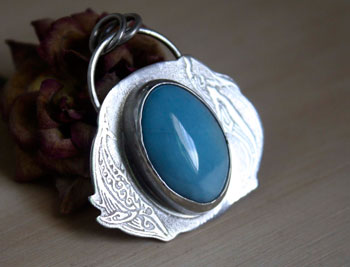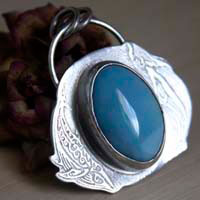- Jewelry
- Inspiration
- Good Deals
- Paintings
- About
- Contact
JEWELRY
- Anklet
- Bracelets
- Brooches
- Cufflinks
- Earrings
- Pendants & Necklaces
- Rings
- Draw your jewelry
- GOOD DEALS
- How to clean your jewel
- Metal we used
INSPIRATION
Larimar: history, healing properties and lithotherapy

Larimar properties

Larimar, a unique variety of blue pectolite, has its exclusive origin in the Dominican Republic. While pectolite can be found in several regions of the world, the exceptional blue hue that characterizes larimar exists only in this specific area of the Caribbean, primarily in the mountainous regions of the Barahona province. Its distinctive color comes from the partial replacement of calcium by traces of copper during its formation, which gives it a unique chromatic palette.
Larimar is a silicate stone belonging to the inosilicate group, composed mainly of silicon, calcium, and sodium, with the notable addition of copper as a coloring agent. Its chemical formula is NaCa₂Si₃O₈(OH).
Its formation is closely linked to volcanic activity. Larimar forms in volcanic chimney conduits known as vugs, under the pressure of gases and the gradual cooling of magma. These specific geological conditions allow the crystallization of pectolite in bluish hues, ranging from white to deep oceanic blue.
The color spectrum of larimar stretches from ethereal white to captivating deep blue, offering a dazzling palette of shades. Among these, the most sought-after stones display intense, luminous blue tones, often interlaced with white marbling reminiscent of sea foam on a tropical ocean. Some varieties reveal greenish or reddish reflections due to the presence of mineral inclusions such as hematite or other metal oxides. These rarer variations further enrich the aesthetic diversity of this gemstone.
Rightly nicknamed the "Dominican turquoise," larimar evokes both the colors of Caribbean waters and a deep connection to marine nature. It is also called "Stefilia’s stone," in tribute to the daughter of Miguel Méndez, one of the first to popularize this gemstone in the 1970s. Some refer to it as the "stone of Atlantis," a mystical name that references legends suggesting larimar originates from the remnants of the lost continent of Atlantis. Other names include "dolphin stone" or "blue pectolite."
Despite its radiant beauty, larimar is a relatively fragile stone. On the Mohs scale, its hardness ranges between 4.5 and 5, which makes it susceptible to scratches and impacts. It is also prone to discoloration over time, particularly under direct sunlight. Prolonged exposure can alter its blue hue, gradually causing it to fade.
To preserve the natural luster of larimar, it is recommended to:
- Avoid prolonged exposure to bright light or heat.
- Refrain from using harsh chemical products during cleaning.
- Opt for gentle cleaning with clear water and a soft, non-abrasive cloth.
By taking care of this precious stone, it is possible to maintain its natural splendor and vibrant energy for many years to come.
Stories, legends and beliefs about the larimar
The fascinating history of larimar dates back to 1916, when Father Miguel Domingo Fuertes de Loren discovered this unique stone in the Dominican Republic. Unfortunately, his request to establish a mine was initially denied by the authorities, who were unfamiliar with the mineral.
It wasn’t until 1974 that the deposit was rediscovered. By 1976, the first mining activities began. The story of this rediscovery reads like a tale: two residents of the peaceful village of Chupaderos were the first to spot the sparkling blue stone in the crystal-clear waters of a river. Driven by curiosity and hope, they embarked on a journey along the river’s course, overcoming nature’s challenges to finally locate the source of this mysterious stone.
The name “larimar” was coined by one of them, who combined part of his daughter’s name, Larissa, with the Spanish word for the sea, “mar”, paying tribute to its evocative color reminiscent of the turquoise waters of the Caribbean.
Today, the Los Chupaderos mine is divided into two sections: one managed by the government and the other operated by the local population. The extraction of larimar remains an artisanal activity, often laborious and carried out under difficult conditions, yet performed with great pride by Dominican miners.

Larimar, sometimes referred to as the Atlantis Stone, is shrouded in mystery and intrigue, fueled by the fascinating prophecies of Edgar Cayce (1877–1945). This renowned American mystic and clairvoyant had predicted, approximately 30 years before the rediscovery of larimar, the emergence of a blue stone with powerful healing and communicative properties in the Caribbean islands. According to his visions, these islands would be remnants of Atlantis, the mythical continent swallowed by the sea.
For Edgar Cayce, this blue stone played a central role in the creation and vibrational energy of Atlantis. Although these claims remain controversial and are more myth than science, they add a mystical dimension to larimar’s history. This legendary aura continues to fuel speculation about its origins and mystical powers, further enhancing its allure in the fields of crystal healing and spiritual beliefs.
Beyond the legends, larimar has also become a powerful cultural symbol for the Dominican Republic. The stone is often showcased in artisanal jewelry, such as pendants, bracelets, and rings, which embody the natural elegance of the Caribbean. For the locals, it represents both the natural beauty of their country and their unique mineral heritage.
Today, larimar is celebrated as a national treasure of the Dominican Republic, admired for its rarity, its captivating history, and its association with ancient myths.
Mines: Dominican Republic.
Healing properties and benefits of larimar
Larimar, renowned for its healing properties, offers a wide range of benefits both physically and emotionally:
- It is said to soothe stress in expectant parents and prevent postpartum depression, providing essential emotional support during this delicate period.
- Larimar is believed to reduce the frequency and intensity of hot flashes, bringing relief to individuals experiencing menopausal symptoms.
- By promoting cartilage flexibility, it helps improve joint mobility and alleviate discomfort associated with conditions such as arthritis.
- Larimar is thought to possess soothing properties for the throat, helping to relieve sore throats, irritations, and respiratory inflammations.
- When placed on the skin, it is believed to improve blood circulation in joints and narrowed veins, offering relief for circulatory issues such as varicose veins or poor circulation.
- It may help combat high blood pressure and stress-related illnesses, thereby contributing to better cardiovascular health.
- Larimar is said to exhibit antipyretic, antimicrobial, and anti-inflammatory properties, aiding in the fight against fevers, infections, and inflammation.
- It is beneficial for treating stress-related skin conditions such as hives, eczema, and psoriasis, offering a calming and reparative effect on the skin.
- Larimar is considered a stone of inner peace, helping to dispel negative thoughts and soothe anger and inner tensions.
- It encourages honest communication, facilitating the expression of buried truths and the resolution of personal conflicts.
- Closely associated with the throat chakra, larimar helps open communication channels and enhances self-confidence to express oneself freely.
- Linked to the sea and aquatic energies, larimar symbolizes the flow of emotions, promoting balance between the body and mind.
- It is highly valued in meditation practices as it helps achieve a deep state of calm, harmonizes energies, and stimulates spiritual connection.
- Due to the presence of copper in its composition, larimar inherits the virtues of this mineral, which is known for its anti-inflammatory properties and its ability to promote tissue regeneration.
 Please note that all healing properties presented for gemstones are gathered from various sources. This information is provided as a service and is not intended to treat medical conditions. It is recommended to consult a healthcare professional for serious medical issues and not to rely solely on gemstones as a treatment.
Please note that all healing properties presented for gemstones are gathered from various sources. This information is provided as a service and is not intended to treat medical conditions. It is recommended to consult a healthcare professional for serious medical issues and not to rely solely on gemstones as a treatment.
Larimar jewelry samples
To learn more about litotherapy, we recommend you the following books:







